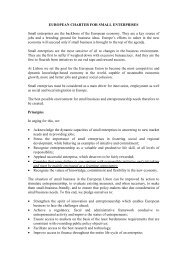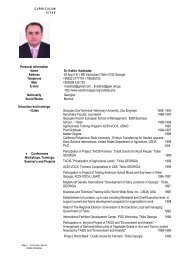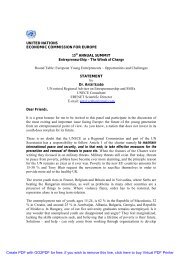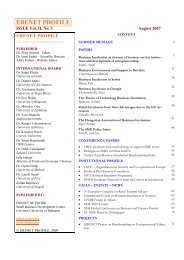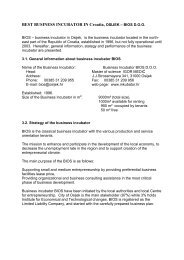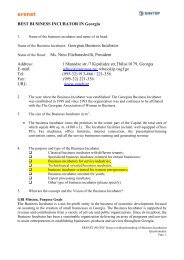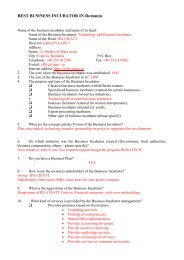(iii)Share <strong>of</strong> <strong>the</strong> labor force <strong>of</strong> <strong>SME</strong>s in <strong>the</strong> total labor force <strong>of</strong> a country. Index <strong>of</strong><strong>SME</strong> <strong>Development</strong> can be expressed in terms <strong>of</strong> percentage <strong>and</strong>/or GDP percapita.It is difficult to state that a country with <strong>the</strong> highest Index has <strong>the</strong> most entrepreneurialculture or <strong>the</strong> <strong>SME</strong> sector is <strong>the</strong> most developed <strong>and</strong> advanced one. However, it provides agood tool for comparative analysis <strong>and</strong> highlight <strong>the</strong> trend in changing <strong>the</strong> <strong>SME</strong> environmentenabling or hindering <strong>and</strong> depressing <strong>the</strong> entrepreneurs.INDEX OF <strong>SME</strong> DEVELOPMENT IN THE BSEC COUNTRIESbased on UNECE methodologyTable 2.CountryShare <strong>of</strong>privatesector inGDP 1[ % ]Share <strong>of</strong><strong>SME</strong> sectorin GDP 2[ % ]Share <strong>of</strong>labourforce <strong>of</strong><strong>SME</strong>s intotallabourforce 3[ % ]GDPpercapita 4[US$]Index <strong>of</strong><strong>SME</strong><strong>Development</strong>[ - ]Index <strong>of</strong><strong>SME</strong><strong>Development</strong>[US$]Albania 75 64 60 2,898 0.288 835Armenia 75 40.3 35.1 1,888 0.106 200Azerbaijan 60 26 7 53 7 2,336 0.083 193Bulgaria 75 39 8 51.5 9 3,995 0.114 456Georgia 70 12 10 27 10 1,779 0.023 40Greece 60 5 27.4 11 86.5 12 27,610 0.142 3,927Moldova 65 27 22 957 0.039 37Romania 70 55 57 5,633 0.219 1,236Russia 65 45 40 6,856 0.117 802Serbia 55 65.5 56 4,220 0.202 851Turkey 80 6 27.3 11 76.7 13 5,408 0.168 906Ukraine 65 10 15 2,274 0.00975 22Source:ERENET Database, 2007.Remarks:1. EBRD Transition Report 20062. Autors <strong>of</strong> <strong>the</strong> current report <strong>and</strong> UNECE Databank 20043. Autors <strong>of</strong> <strong>the</strong> current report <strong>and</strong> UNECE Databank 20044. IMF World Economic Outlook Database, April 20075. https://www.cia.gov/library/publications/<strong>the</strong>-world-factbook/geos/gr.html6. 2004 Regular Report on Turkey's Progress Towards Accession, Commission <strong>of</strong> The European Communities,Brussels, 6.10.2004 SEC(2004) 12017. Including <strong>the</strong> agrar sector. Withouth <strong>the</strong> agrar sector only 18% respectively 24% only.8. Annual Report on <strong>SME</strong>s in Bulgaria prepared by <strong>the</strong> Ministry <strong>of</strong> Economy <strong>and</strong> Energy.http://www.mee.government.bg/ind/doc_eco/Annual.Report.on.<strong>SME</strong>s.SPECIAL.EN.pdf9. National Statistical Institute, S<strong>of</strong>ia, http://www.nsi.bg/public_e/MSP04.html10. No <strong>of</strong>ficial statistical data is available. Information from <strong>the</strong> Gerogian Association <strong>of</strong> Women in Business fromTbilisi.11. Small <strong>and</strong> Medium Enterprises across <strong>the</strong> Globe , Meghana Ayyagari, Thorsten Beck <strong>and</strong> Asli Demirgüç-Kunt12. Small <strong>and</strong> Medium Sized Enterprises Sector (AGCAS), Claire Rigby <strong>and</strong> John Trantom (Liverpool John MooresUniversity), edited by Jamie Swann13. <strong>SME</strong> Strategy <strong>and</strong> Action Plan, Republic <strong>of</strong> Turkey Prime Ministry State Planning Organization14
3. EXPANDING SOUTH EAST EUROPE TO THE REGION THE AREA OF PEACE,STABILITY, PROSPERITY BY DEVELOPMENT OF ENTREPRENEURSHIP. -REVIEW OF THE <strong>SME</strong> SECTOR IN ALBANIA, BULGARIA, ROMANIA ANDSERBIA 163.1 ALBANIA3.1.1. <strong>SME</strong> SECTOR DEVELOPMENTAfter <strong>the</strong> long period <strong>of</strong> isolation Albanian economic reforms <strong>of</strong> <strong>the</strong> first decade <strong>of</strong>transition were much focused on <strong>the</strong> areas <strong>of</strong> privatization, deregulation <strong>and</strong> liberalizationefforts in all sectors <strong>of</strong> <strong>the</strong> economy. As result, over <strong>the</strong> last few years, growth averaged atclose to 6% <strong>and</strong> for 2005, <strong>the</strong> real GDP growth rate was 5.5%. Economic growth over thisperiod was accompanied by ongoing consolidation <strong>of</strong> macroeconomic equilibrium, beingevidenced in overall stable monetary indicators, low <strong>and</strong> stable inflation rates, <strong>and</strong> in <strong>the</strong>reduction <strong>of</strong> budget deficit <strong>and</strong> public debt.The substance <strong>of</strong> <strong>the</strong> important measures undertaken by <strong>the</strong> Albanian Governmentremains <strong>the</strong> reforms for <strong>the</strong> development <strong>of</strong> <strong>the</strong> private sector, especially for <strong>the</strong> <strong>SME</strong>s. Since2001 a national strategy paper for <strong>the</strong> development <strong>of</strong> <strong>the</strong> <strong>SME</strong>s was drafted by <strong>the</strong> Ministry <strong>of</strong>Economy <strong>and</strong> approved by <strong>the</strong> Government <strong>of</strong> Albania. Most <strong>of</strong> <strong>the</strong> actions are related tomeasures which contribute to relaxing <strong>of</strong> bureaucratic barriers to <strong>the</strong> business establishment<strong>and</strong> operation, enhancing <strong>the</strong> transparency <strong>of</strong> <strong>the</strong> public administration on its relations with <strong>the</strong>private sector <strong>and</strong> improving <strong>the</strong> policy making <strong>and</strong> institutional set up in support <strong>of</strong> <strong>SME</strong>s.Overall objective <strong>of</strong> Government <strong>SME</strong> strategy is to create a positive business developmentclimate to allow for sustainable <strong>SME</strong> growth. Its specific objectives are: encouraging <strong>the</strong>expansion <strong>of</strong> existing businesses <strong>and</strong> <strong>the</strong> creation <strong>of</strong> new ones (Start-ups), including <strong>the</strong>transformation <strong>of</strong> traders into investors in production, while simultaneously supportingproduction for export <strong>and</strong> <strong>SME</strong> joint-ventures. To reach <strong>the</strong> above objectives a number <strong>of</strong>concrete measures will be taken, such as:• Institutional streng<strong>the</strong>ning <strong>and</strong> development through <strong>SME</strong> policy <strong>and</strong> programdevelopment <strong>and</strong> delivery <strong>of</strong> <strong>SME</strong> support services via intermediary institutions (such as<strong>the</strong> Chambers <strong>of</strong> Commerce, Regional <strong>Development</strong> Agencies, business associations,consultancy companies, etc.);• Working towards a transparent legal <strong>and</strong> fiscal framework which is conducive to <strong>SME</strong>sdevelopment;• Improving <strong>the</strong> management <strong>of</strong> <strong>SME</strong>s, via training programs delivered by intermediaries;• Improving access to finance by exp<strong>and</strong>ing micro-finance <strong>and</strong> initiating new tools such ascredit guarantee schemes, seed capital, leasing, etc;• Achieving balanced regional <strong>and</strong> sectoral development through incentives to stimulate<strong>SME</strong>s development in deprived areas <strong>and</strong> regions.Taking in consideration <strong>the</strong> number <strong>of</strong> persons employed in a firm, Albanian Law No.8957, Small <strong>and</strong> Medium Size Enterprises as <strong>of</strong> 17 October 2002 uses <strong>the</strong> following criteria for<strong>SME</strong> classification:• Micro enterprises: up to 5 employees;• Small enterprises: 6 - 20 employees;• Medium-size enterprises: 21 - 80 employees;• Large enterprises: over 81 employees.16Prepared by Dr. Eriæ DEJAN, Associate Pr<strong>of</strong>essor School <strong>of</strong> Economics, University <strong>of</strong> Belgrade, Belgrade BankingAcademy15
- Page 4 and 5: 1. SME DECLARATION AND WORKING GROU
- Page 6 and 7: While comparing the BSEC and EU doc
- Page 8 and 9: cooperation with the United Nations
- Page 10 and 11: GENERAL ASSESSMENT OF THE BSEC WG O
- Page 12 and 13: “Armenia's new law introduces a n
- Page 16 and 17: The following data represents some
- Page 18 and 19: RankDocuments for export(number)Tra
- Page 20 and 21: • Industrial zones/Business incub
- Page 22 and 23: 3.1.4. FINANCING SMEsProf. Dr. Sela
- Page 24 and 25: • the loan is secured with movabl
- Page 26 and 27: 3.1.4.3. Mutual and loan guarantee
- Page 28 and 29: introduction of e-signatures, only
- Page 30 and 31: The Code of Conduct for Civil Serva
- Page 32 and 33: Trading Across Borders Enforcing Co
- Page 34 and 35: as with all non-governmental organi
- Page 36 and 37: Bulgarian SMEs obtain additional ca
- Page 38 and 39: • Project BG 2004/016-711.11.04 -
- Page 40 and 41: usiness is not approaching them oft
- Page 42 and 43: • Romanian citizens are recognize
- Page 44 and 45: The preparatory project of the NDP
- Page 46 and 47: • To support participation in eco
- Page 48 and 49: In 2004, the National Institute of
- Page 50 and 51: Incubators host on average 11 SME,
- Page 52 and 53: Programs. The program is implemente
- Page 54 and 55: development instrument is extremely
- Page 56 and 57: accounting standards, including med
- Page 58 and 59: corporations and open held corporat
- Page 60 and 61: promoting SME sector, cooperation w
- Page 62 and 63: • for unemployed (micro credit)
- Page 64 and 65:
are private pension funds, broker h
- Page 66 and 67:
very early steps of its democratic
- Page 68 and 69:
Another negative factor that is mor
- Page 70 and 71:
economy. The so called in the organ
- Page 72 and 73:
Federal funds, private capital, esp
- Page 74 and 75:
4.3. MOLDOVATable 14.Dimensions Neg
- Page 76 and 77:
Related andsupportingindustriesDome
- Page 78 and 79:
Technological:Internetaccessibility
- Page 80 and 81:
Domesticdemand• Still not many pe
- Page 82 and 83:
international investments• Govern
- Page 84 and 85:
3. Hamel, G., Prahalad, C.K. (1994)
- Page 86 and 87:
5.2 DEVELOPMENT OF THE SME SECTOR I
- Page 88 and 89:
General Characteristic of SME Devel
- Page 90 and 91:
Index of SME Development in Armenia
- Page 92 and 93:
The same problem exists in getting
- Page 94 and 95:
SME support infrastructure in Armen
- Page 96 and 97:
5 million was provided by UNDP and
- Page 98 and 99:
5.3 DEVELOPMENT OF THE SME SECTOR I
- Page 100 and 101:
Diagram 1. The number of small ente
- Page 102 and 103:
The privatization process of object
- Page 104 and 105:
13.Cabinet Provision on “Distribu
- Page 106 and 107:
5.3.3. SME support infrastructure i
- Page 108 and 109:
The role of the state in technical
- Page 110 and 111:
General situation of credit marketT
- Page 112 and 113:
After creation and starting impleme
- Page 114 and 115:
At the meantime, small enterprise s
- Page 116 and 117:
Table. 32.Ease of businessDoingBusi
- Page 118 and 119:
people who start small businesses t
- Page 120 and 121:
are salaried and the medium - sized
- Page 122 and 123:
Technology Foresight in Greece 2001
- Page 124 and 125:
Greek VC market started to develop
- Page 126 and 127:
In the area of bankruptcy and restr
- Page 128 and 129:
enterprises. According to TURKSTAT,
- Page 130 and 131:
small size enterprise or micro ente
- Page 132 and 133:
industrial enterprises. Undersecret
- Page 134 and 135:
individuals, rather than well struc
- Page 136 and 137:
7. SUGGESTIONS FOR THE SME DEVELOPM
- Page 138 and 139:
Annex 1.MAP OF THE BLACK SEA COUNTR
- Page 140 and 141:
17-18 June 2005 1 st Moscow Interna
- Page 142 and 143:
ARMENIASTRENGTHS• Application of
- Page 144 and 145:
BULGARIASTRENGHT• Flexibility and
- Page 146 and 147:
GREECESTRENGHT• They have a vital
- Page 148 and 149:
ROMANIASTRENGHTWEAKNESS• Stabilis
- Page 150 and 151:
REPUBLIC OF SERBIASTRENGHT• Longe
- Page 152 and 153:
UKRAINESTRENGTHS• Well educated l
- Page 154 and 155:
In compliance with the Resolution m
- Page 156 and 157:
1. Please provide definition of SME
- Page 158 and 159:
7. Did you establish a dedicated bo
- Page 160:
11. Do you have any suggestions for



